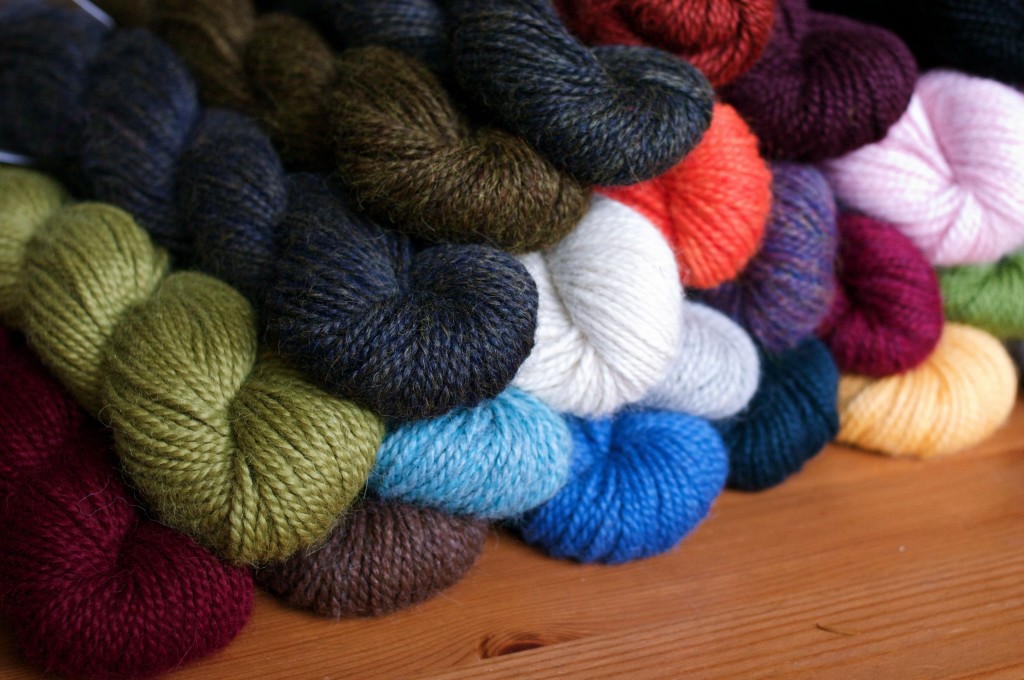Back by popular demand is the subbing tutorial. What I neglected to mention in the last post is how to tell how much yarn you will need! Another popular question around the shop is ‘How many skeins will I need for a _______’. While we are always near by with a calculator around the shop, here are a few tips to figure out how much yarn you will need.
One of the things I hear a lot is yarn requirements that are given by weight. There are many patterns in the world that are written with amount requirements in ounces or grams, especially (although not restricted to) older patterns. Elizabeth Zimmerman, for example, gives weights in all of her patterns. I have a theory about this: there are just more yarns out there now. If there are only a few types of yarn, mostly wool, it’s easy to go by weight. Now, there are so many different yarns and fibers, I just don’t think weight is accurate enough.
Lots of people come to UY looking for 4 oz of wool or five 50 gram balls. This works fine if you are using the exact yarn in the pattern, meaning the same brand of yarn. If you have a Debbie Bliss pattern and you are using Debbie Bliss yarn you are good to go! Simple. As soon as you start subbing this becomes a problem. Here’s why: different fibers weigh different amounts for the same yardage. Alpaca and angora are very light fibers, so you will get more yardage for the same weight. Silk, on the other hand, is a lot heavier than wool. If you have a fiber that is a mix, then all bets are off and I would look to our good friend the ball band to tell us how much yardage is in there.
So what should you do if you want to start subbing yarns?
Step one: check out the original yarn. If you are subbing you will already want to look up the gauge so make a note of how many yards per skein while you are at it. A couple of things to be careful of though:
- make sure you are measuring either meters or yards and keep it consistant. There are 109 yards per 100 meters FYI.
- The other thing to be careful of is the occasional change in skein size. Every once in a while a yarn company will change the size of their skeins from 50g to 100g or vise versa or something else entirely. Make sure you are looking at the same size skein.
Step two: Once you have determined how many yards per skein the original yarn had, do a little multiplication and figure out how many yards you will need to make your sized garment.
Step three: check how many yards (or meters) the yarn you are substituting has. Yardage needed divided by the yardage of the substituted skein gives you the number of skeins you will need of the substituted yarn.
Now, the above advice is great if you are working from a pattern but what if you are that wild knitter who is stashing for the right pattern to come along or *gasp* designing their own garment? Well, it is a little tougher but there are a few basic guidelines you can follow in a lovely little pamphlet of yarn requirements. It’s been my yardage bible for the past couple of years, you can pick one up at the shop for about $6 and it’s an invaluable tool. The Knitter’s Handy Guide to Yarn Requirements.
I would also recommend buying an extra ball or skein, especially if you are making a garment. It is exchageable if you don’t need it and I have seen more than a few regrets over unpurchased extra yarn. Remember that every knitter is a little different and sometimes the best laid plans can go awry. Even if all signs point to 8 ball, you just might need a little bit more.
Voila! Now you’ll be able to sub yarns at will. Don’t let substitutions scare you, being able to knit things many different ways, with different yarns, fibers, and style is what makes knitting so great. It makes each item unique. Also, we would be happy to walk you through substitutions in the shop any time!
–Alexa–

I think you missed a decimal there – a math whiz I am not, but I doubt there are 109 yards per metre!
great info once again… OK, a little missed decimal or “per 100 meters….”
still , I think you made it all very straight forward.
Thanks Alexa!
Thanks for the tutorial!
Alexa,
Thanks for putting this great information “on paper”.
I would like to print this and bring a copy to each of the ladies in my knitting group as many of them have difficulties when subbing yarn.
Would you be okay with that?